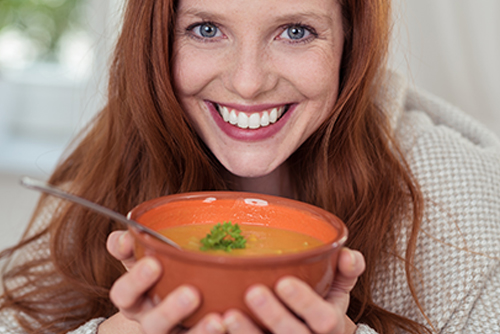We all want our kids to be happy and healthy. But feeding children can throw up many
We all want our kids to be happy and healthy. But feeding children can throw up many challenges for parents and carers and so many questions.
Is this healthy?
Will they eat it?
How do I know they’re getting enough of the right foods?
How do I get my kids to eat vegetables?
With all the questions and varying opinions around what you should and shouldn’t do, it can seem overwhelming. But don’t freak out! Food and eating shouldn’t cause so much angst. With a common sense and gentle approach, you can encourage your kids to create healthy eating habits from the start. Here’s some simple steps to get you started:
Be a positive role model
One of the best ways to teach children about healthy eating is by example. Children learn by watching, listening and observing adults and then following what they see. Rather than trying to strictly control your child’s diet, try modelling healthy eating habits.
For example:
- Be a good role model — eat a balanced variety and amount of nutritious foods and drinks, eat breakfast and do not skip meals
- Make nutritious food options readily available at home.
- Talk about healthy foods and what they do for your body. “These carrot sticks contain a super nutrient called beta carotene that helps my eyes stay sharp and focused”
- Explain the difference between “everyday” foods and “sometimes” foods and model eating “sometimes” foods in moderation, without talking about being bad or feeling guilty.
Involve them
Have your children participate in meal preparation and encourage an understanding of the origins of food. Georgia Harding from
Well Nourished recommends creating a ’food culture’ in your household as an important foundation for developing healthy eating patterns in your children. What does this mean? Simply talking to your children about food, where it is from and why it is so wonderful. By incorporating a knowledge and passion for food into their lives, you can profoundly influence a child’s interest and desire for whole foods.
It’s important to make sure children’s involvement with food is fun, not a chore. Georgia recommends patience, persistence, positivity and praise. Even if it’s only for a few minutes, any involvement is a step towards a lifelong appreciation of food. Some simple ways to involve kids:
- When shopping for food, let your kids help choose and bag fruits and vegetables at the supermarket or farmers market.
- Cook meals at home and try to encourage your children to help you. Tasks such as mixing, whisking, stirring, cracking eggs, peeling or grating vegetables, spinning salad leaves, scrubbing potatoes, picking leaves off herbs
- Let them help pack the school lunchbox. Younger kids might just pack the prepared foods from the chopping board into the box. Older kids might pack their entire lunch.
- When meal planning, give them a chance to provide input. You can set boundaries, such as it needs to be a home-cooked meal, or decide on the main element and let them have input into the accompanying sides. For example, “we’re having steak tonight, would you like mashed or baked potato?”
- Older kids love to play restaurants where they set the table, write out menus and serve the dinner.
Prioritise family meals
Regular family meals can help kids develop a healthy attitude towards food, and it also gives you a chance to role model healthy eating patterns. Family traditions based around meals, such as a Sunday roast, can help children develop positive memories with food.
So as often as possible, try to eat together around the dinner table and turn off the TV. You are more likely to get the most out of family meals if you focus on connecting with your child rather than on what or how much they are eating. If the discussion turns to the food – try to stimulate some fun discussion such as guessing the ingredients in the meal, or describing a food’s texture and what it can do for your body or health.
As much as possible, discourage eating in front of the TV or computer. Often this leads to mindless eating without paying attention to hunger cues and can result in the consumption of unnecessary kilojoules (energy).
Don’t use food as a reward or punishment
It’s best to avoid using foods to calm or soothe an upset child, as it can set up an association between food and managing emotions. Although tempting, food shouldn’t be used to reward or bribe, try using activities or experiences such as a trip to the park, or a board game after dinner as alternative rewards.
The best actions to take to avoid your child creating an emotional relationship with food include:
- Finding non-food ways to praise and reward children, for instance create a sticker chart or by spending time together
- Praise children for their character rather than their weight or what they eat
- Express your love through giving hugs or telling your children that you love them rather than by using food
- Help your child explore other techniques to calm down
Give them choices
We want our children to practice mindfulness in their eating habits, so we need to allow them to take some responsibility from the start. Most children are great at eating to their hunger so let your child stop eating when they don’t want anymore. Pressuring a child to eat more also has negative consequences, since it lessens their ability to regulate their own energy intake.
One technique is to adopt a “parent provides, children decide” philosophy. Have a variety of food available, but encourage your children to take the responsibility for their eating choices, by taking food and drink from that selection. You do not need to have all types of food in every meal — children will absorb the nutrients they need over time so look at their dietary intake over a week or two.
Here are some ways we can help our children eat only when they are hungry:
- Help your child to identify feelings of hunger and fullness.
- Avoid telling them to eat everything on their plate.
- Avoid strict rules around the foods your child eats but ensure healthy food options are readily available in the home.
- Always offer variety. It may take many attempts for your child to like a new food, so don’t give up. Offer small amounts and try presenting it in a fun engaging way.
- Allow your child to eat “sometimes” foods in moderation, banning can encourage over-eating when they are available.
There’s a lot of information provided here. But perhaps the most important tip we can give is to keep calm and take small steps. Building healthy relationships with our food takes time and persistence – so don’t expect everything to change overnight. Gradually introducing some of the methods outlined above will set your children on the path to positive eating habits which will provide a lifetime of benefits.




